|
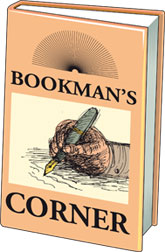
Reality in fantasy and fantasy in reality
Reviewed by Ranga Chandrarathne
The novel A Roadside Saga by Aruna Shantha Nissanka is an important
contribution to Sri Lankan literature in English. It stands out for both
the impressive narrative style and the manner in which the author deals
with myriads issues within a matrix of turbulent times.
The story is woven around the bizarre incidents taking place in a
farm where the protagonist Arkanshak assumes duties as the deputy
manager. He stays in the bungalow with his pregnant wife Aryoma. The
story shifts from reality to fantasy and vice versa. For instance, dogs,
who feed on a body of a killed man, speak and clash with the people of
the village. However, the novel concludes with the protagonist Arkanshak
going into the wild indirectly signaling whether anarchist political
environment in the village is the end of the civilisation.
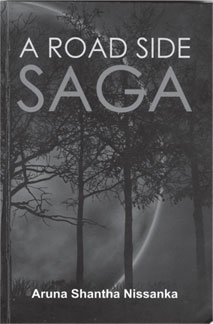 |
|
A Roadside Saga
Author : Aruna Shantha Nissanka |
“In contrast to the past days, clouds resisted heavily that night and
remained stuck even after the mid night still damp, cool wind started
blowing gently fanning the sleepers into sound sleep. Towards the crack
of the dawn the damp stillness of the morning air heightened the rattle
of guns echoing on the mountain massif rising far away. The farm and the
village that partly skirted it were stirred by the rattle that lasted
for a few seconds. And the dwellers raised their eyelids heavy with
sleepiness to spend a few hours of sleepless suspense till the sunlight
of the day break. The suspense and the fear of those awakened grew up as
they failed to locate the direction of the gunfire.
The first round of the gunfire brought Arkanshak into a half-awakened
and half-sleep state. Lying in a semi-conscious state he took rattling
as somebody disturbing the corrugated iron sheets of the poultry pens.
He became disillusioned with the sound as he heard the second round of
gunfire…..No doubts around the main gate…outsiders…automatic
weapons…killing squads..”
The author brilliantly portrays the volatile political atmosphere in
which the killer squads become the order of the day. Although one could
draw a parallel with the turbulent times during the period of terror in
the 1980s , the unfolding scenes in the novel may occur in any part of
the world under similar circumstances. It could be in the North and the
East of Sri Lanka or in the South or in Ethiopia.
Political violence as a sub-text
The novel commences with the murder of the watcher of the farm.
Although no one has claimed responsibility for the murder, it is obvious
that it was carried out by a Para- military group that roamed the area.
However, the novel does not extensively record the bizarre incidents
of the period in grotesque manner. The authorial voice always expresses
through the protagonist Arkanshak who witnesses the political violence,
internecine killings and their impact on society. It is not a realistic
description as dogs who feed on the body of the killed watcher begin to
speak and to taste the human flesh. At most of the times, social reality
is couched in fantasy and the thin line between fantasy and reality is
rather blurred so that it creates a surreal effect on the readers.
However, it is obvious that the narrative style adapted by the author is
the one which is demanded by the plot.
In The Literary Theory, Eagleton describes the distinction between
fact and fiction ; “A distinction between 'fact' and 'fiction', then,
seems unlikely to get us very far, not least because the distinction
itself is often a questionable one. It has been argued, for instance,
that our own opposition between 'historical' and 'artistic' truth does
not apply at all to the early Icelandic sagas. In the English late
sixteenth and early seventeenth centuries, the word 'novel' seems to
have been used about both true and fictional events, and even news
reports were hardly to be considered factual. Novels and news reports
were neither clearly factual nor clearly fictional: our own sharp
discriminations between these categories simply did not apply. Gibbon no
doubt thought that he was writing the historical truth, and so perhaps
did the authors of Genesis, but they are now read as 'fact' by some and
'fiction' by others; Newman certainly thought his theological
meditations were true but they are now for many readers 'literature'.
Moreover, if 'literature' includes much 'factual' writing, it also
excludes quite a lot of fiction. Superman comic and Mills and Boon
novels are fictional but not generally regarded as literature, and
certainly not as Literature. Ifliterature is 'creative' or 'imaginative'
writing, does this imply that history, philosophy and natural science
are uncreative and unimaginative? Perhaps one needs a different kind of
approach altogether. Perhaps If iterature is definable not according to
whether it is fictional or 'imaginative', but because it uses language
in peculiar ways. On this theory, literature is a kind of writing which,
in the words of the Russian critic Roman Jakobson, represents an
'organized violence committed on ordinary speech'.
Literature transforms and intensifies ordinary language, deviates
systematically from everyday speech. If you approach me at a bus stop
and murmur 'Thou still unravished bride of quietness,' then I am
instantly aware that I am in the presence of the literary. I know this
because the texture, rhythm and resonance of your words are in excess of
their abstractable meaning - or, as the linguists might more technically
put it, there is a disproportion between the signifiers and the
signifieds.
Your language draws attention to itself, flaunts its material being,
as statements like 'Don't you know the drivers are on strike?' do not.
This, in effect, was the definition of the 'literary' advanced by the
Russian formalists, who included in their ranks Viktor Shklovsky,
Roman]akobson, Osip Brik, Yury Tynyanov, Boris Eichenbaum and Boris
Tomashevsky.
The Formalists emerged in Russia in the years before the 1917
Bolshevik revolution, and flourished throughout the 1920s, until they
were effectively silenced by Stalinism.
A militant, polemical group of critics, they rejected the
quasi-mystical symbolist doctrines which had influenced literary
criticism before them, and in a practical, scientific spirit shifted
attention to the material reality of the literary text itself. Criticism
should dissociate art from mystery and concern itself with how literary
texts actually worked: literature was not pseudo-religion or psychology
or sociology but a particular organisation of language. It had its own
specific laws, structures and devices, which were to be studied in
themselves rather than reduced to something else. The literary work was
neither a vehicle for ideas, a reflection of social reality nor the
incarnation of some transcendental truth: it was a material fact, whose
functioning could be analysed rather as one could examine a machine. It
was made of words, not of objects or Feelings, and it was a mistake to
see it as the expression of an author's mind. Pushkin's Eugene Onegin,
Osip Brik once airily remarked, would have been written even if Pushkin
had not lived. “
Decadence of civilisation
The ending of the novel is as abrupt as the beginning of it. The
author’s utter disgust at violence and upheavals of society is amply
manifested when the protagonist Arkanshak leaves civilisation and goes
into the wilderness.
“ … The most faithful followers of man might have expected its long
time friend would help it in its struggle for life. Aryoma, how can we
befriend the dog?
How can we re-start and re-spin history ? …Last night , when I was to
leave for the burial of your man, I uttered the same words. How can I
believe you utter the same words now…. For its life or what we call life
….common to all living beings, she said calmly”.
The Wildman who appears with a huge dog from time to time in the
village is an important symbol in the novel. Wildman on one hand
symbolises the rudimentary form of human existence to which society is
debased following social upheavals and the ensuing anarchic situation
and the sub-conscious mind of the protagonist on the other hand. When
society plunges into its deepest abbeys, it involuntarily becomes wild
and would be similar to barbaric society where survival of the fittest
is the order of the day. Arkanshak goes into the wild to escape from the
violence of the society and lives with wild man’s wife.
Intertexuality
Intertexuality (story within a story) is one of the effective
literary techniques that the author employs throughout the novel. It is
not only the political upheaval and the turbulent times that the author
depicts in the novel but the unfolding human tragedy. When the ‘leather
boots’ follow a target, the targeted man or woman has nowhere to escape
into.
This harsh reality of war is expressed through the dog’s words; “ I
am the only one living to know the hide-out of the jungle except my
mistress …I think you don’t want me to share the secrets of the jungle
with leather boots” .
The dog leading Arkanshak to the wild is one of the instances where
the reality merges with fantasy and in a way the reality of violence is
expressed through fantasy.
Symbolism
One of the significant aspects of the novel is the use of symbols. At
times, reader may feel that the entire setting; a farm is an allegory of
a closely-monitored and controlled society. Though the incidents in the
novel seem far from realistic and credible, they can happen in a similar
way in any society following a violent political upheaval or war.
Noted for its impressive narration and apt use of symbolism and
modern literary devices, A Roadside Saga stands out as an important
English novel in the contemporary Sri Lankan writings in English.
A must read for housewives
Reviewed by Therese Motha
Recipes from the cookery book of the last Kandyan dynasty is a book
any housewife who is fond of cooking will be proud to own because it
gives her new insights and methods of cooking for her to experiment
with. For the hotel chef and those aspiring to be chefs, the book will
delight their hearts because of the many permutations each recipe
unfolds. Going through the book I found something of interest in each
section. In the section on meats, I learnt that jak can be successfully
cooked along with any meat to make a delicious dish (recipes nos. 29 and
30). I remember one day, long ago, a friend of my father who was an avid
cook sent us a delicious baked breadfruit stuffed with mincemeat. It was
delicious.
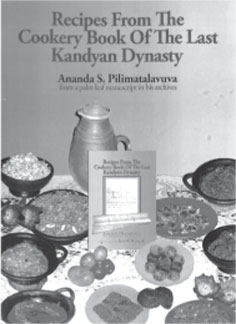 |
|
Recipes from the
cookery book of the last
Kandyan dynasty
Author: Ananda S. Pilimatalavuva |
In the fish section, I came across a very simple recipe for small
fish (recipe no. 5). In the rice section, recipe no. 1 seems to be
something worth trying out. In the cunjee section, recipe no. 5 seems to
be fairly simple to make. In the vegetable section, there is a recipe
for a mallun with green gram which is worth trying. Recipe no. 22 and
recipe no. 15 using either kekiri, brinjal or polos is also rather
straightforward. There is also a kos maaluwa and a polos recipe (nos. 13
and 14). In the sweetmeat section, recipes 6, 7, 8, 9, 14 and 21 all
look worth a try and are easy enough for even a child to try out.
I think the section that interested me most of all was the one on
health benefits and medicinal uses and other names of the various
ingredients. I am ashamed to admit that I did not know that the bo tree
is also referred to as the peepul tree.
These and various other facts I gleaned from perusing this section.
Did you know that koora thampala is amaranthas, that venivel is calamba
wood, goraka is gamboge, katuwelbatu is prickly nightshade, asamodagam
is wild celery and kithul is wine palm? Incidentally, our son-in-law who
is a chef in Australia, made a mallun of asamodagam leaves which was
very palatable. One big bonus is that every recipe page is laminated.
This will prevent hassles among housewives who tend to drop a bit of
curry they are tasting on to the open book on the kitchen table.
All in all, this is a book that should be on every housewife's
bookshelf, to browse through, to read and then experiment with.
Happy cooking to all, housewives and chefs alike!
A dissolution of sorrow and the end of old beginnings
by Carl Muller
Meet him - and you must - and you can now read close on fifty of his
poems he claims are his Letters From Far Away. Letters... or a flow of
thoughts, meditations, obsequies, the telling of the dissolution of
sorrow, the end of old beginnings, long fiery draughts of an ocean that
is life and blank sheets of rising dawns...
Yes, meet Derrick Gamini Pieris Seneviratne - a poet I have been
privileged to know for ever so long; whose ever impending exhalation of
spirit has found his lines in so many anthologies, and I would list them
all if I were given leave to do so. But, as he in An Epilogue (p. 4)
says:
"... we did not seek to weave
old threads into new patterns: common sense
demanded that we build anew
and sentiment could not resist it since
we stood on a concrete experience."
This is Gamini, and it was in November 2009 that his Letters From Far
Away were read, proof-read, and published in greater part by his wife,
in whose memory this, his Requeiescat (p. 7) spins forth:
Yesterday
will be
like again tomorrow
* * *
she will die with me
* * *
Sweet faces
skirts under falling leaves
in the windy avenue at noon
down the school land
* * *
She should have lived
* * *
a little longer, till the buildings changed
and the places disappeared
where the hours speed young with us
under the awning, down the by-path
* * *
to breed brats
* * *
Myself, I should not
have committed this death;
but strangely, I survived.
Let me.
* * *
Let her be born again
* * *
Justice
pleads
that yesterday was blind.
Fresh twilight
To take this collection is to render a fresh twilight that offers a
cleavage in the air-blue sky above and the rosary in a nun's hand. There
is a quality of magic and a seeking for echoes and the silence of doom.
Allow me to offer readers a bowl of so many sensations:
(1) She writes to me, I think. Our letters cross
as the mood takes us. The wrong letters cross.
Thoughts lapse into old patterns
in the stagnant routine of the ring -
feint swing clinch break and once again
feint. No questions, no replies.
Nobody wins. Jeers -
without? within? Echoes in the emptiness;
Everybody's gone to bed. Shadowless
under phantom lights we play
in the invisible ring.
Prospero?
tell us - this Shakespeare -
who was he? (Waiting for Ariel - p. 2)
(2) Poor flesh
God's body is made bread
in the fruit of meditation
for an exultation of the spirit
deflowers the single man
transmigrates the soul
to animal decay
and when the green awakens
to leaf on bare shoulders,
fulfils with putrid scent the queen of the night.
(Meditation - p.3)
(3) Writing now at the end of years
with only a tickling ember of one's hurt
one could not feel, so much, remorse
for what in social terms it meant, nor any regret
for the inundated paradisal isles, only wonder
that beauty is born of friendship and those tears
weren't vainly shed for the innocence we lost
the beauty that in innocence we squandered.
It seems born again now of stony-hearted days
since love was castrate, beauty self-confined
the word compressed in the folds of desire,
indifference in its vacuum refined.
The virgin thought we were so loth to learn
indenting it on time's grim pock-marked face
to prove that passion breeds nothing to admire
and showed us the ways of beauty which is stern.
(Lines from The Second Coming - p 8)
Newer understanding
Do we see a sudden onrush of newer understanding tinged with
old-young regret? Let's take the end-lines of yet another, shall we:
....Tears at departing ties
one's own life close, it rises
to skin-deep, pores tear
Love lingers like the earth,
Rivers flow,
Hills and cities peddle fantasies
The dawn with lift. (From Parting at Dawn (P10)
His Paterfamilias offers four poems - the first For Arjuna, his son,
accosting a portrait of Dorian Gray:
I can see the charm of my figure
in your face, son.
Time
will invest your figure
with the changes that time brings.
Let growing up, for you
be as a seasoning of hard wood
the hardwood that
my face in your figure sometimes sees
which your eyes on me
must less and less detect.
Astral intersections
The next is for his brother, titled Maiyya, which offer what will and
must come to be when all the astral intersections, curves and
consequential tangents slide into space:
....You are still child, son,
freed by the rude beam of your brother's oak
on which your parallels roll to infinity
whose intro-linear graphs provide
nodes for tangencies.
The third is for his daughter Nanga and again we find a new making of
love as though the times are now upon the poet to nerve himself to the
fatherhood he near forgot to give:
And you my daughter, for whom
I have had so few words, survive
the collapse of my lungs.
There will be voices
sweet with singing, voices sweet
singing in the garden, through a high window
as now, in my mind, for you, as you lie asleep.
I see you awake,
dark-eyed your raven hair,
in the arms of a careful mother.
Am I aggrieved, though, though there has been
little conversation between us, as befits
father and daughter?
Devouring nights
The fourth tells of naught but himself and of devouring nights, tired
headlights, hither and thither, country-sides and sentiments, hunger and
the profanities of ill-spent days. Readers will find these Letters From
Far Away projecting the very unconnected corridors of his life. He has
to tell of what of what it has been to await the anguish of dying as
well as the choking of life. We find these lines in Living where he
asks:
"Do the stars
muster configurations
to tug at the threads that bind
this life to this body?" (p 17)
I could go on, and there is so much more, but a few here-and-there
lines carry so much:
....How deep beauty is. How grave our need. How swift to die.
Thank you Lord, for this goodbye, (Beauty - p29)
Take Gamini Seneviratne the way he now wishes to be taken. He has put
every piece of life's jigsaw together and in so doing has sought the
glow of newer moons, brighter suns, an aptitude to live in a frame of
ivory leaf and jasmine. Nothing can now make a new youthfulness retreat.
He has spread his sorry make-up far and seen the new-life sensations
return like a bowl of cascading flowers.
BOOK LAUNCH
Web Adavi Sakasima
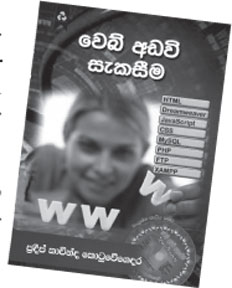
Pradeep Kavinda Kotuwegedara's latest book Web Adavi Sakasima and CD
will be launched at Dayawansa Jayakody bookshop, Ven. S. Mahinda
Mawatha, Colombo 10 on April 12 at 10 a.m.
Web Adavi Sakasima (Web designing) is a Dayawansa Jayakody
publication.
Ektam Geval
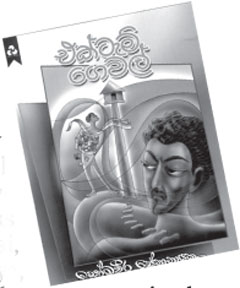
Award-winning author Somaweera Senanayake's Ektam Geval (latest
edition) will be launched at Dayawansa Jayakody Bookshop, Colombo 10 on
April 19 at 10 a.m. Somaweera Senanayake is the author of several books
including Raja Kale Punchi Lamai, Mavakage Geethaya, Yashoravaya, Menik
Nadiya Gala Basi, Paramitha, Andurata Pahanak, Api Thavamath Sansare,
and Sathun Athara Bosathvaru. Ektam Geval is a Dayawansa Jayakody
publication.
|

